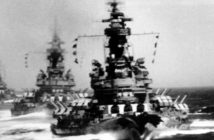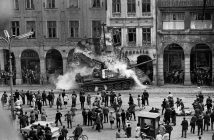Today in Military History: On Sept. 10, 1813, in the Battle of Lake Erie, a nine-ship US Navy squadron commanded by Master Commandant Oliver Hazard Perry defeats a six-ship Royal Navy squadron commanded by Cmdr. Robert Herlot Barclay, who was gravely wounded in the action.
The battle is pivotal in the combined land and seal campaign led by then-Maj. Gen. William Henry Harrison — later America’s ninth president — to retake Lake Erie, which had been controlled by the British since the start of the War of 1812. The effort to build, equip and man an American fleet on one of the Great Lakes was a major effort, and even involved 50 sailors from the USS Constitution, which was out action for refit in Boston. In the time it took the British to build one ship, HMS Detroit, the Americans built six, giving them a superior force.
During the fierce battle, Perry’s ship was the big USS Lawrence, named in honor of his friend Capt. James Lawrence who was killed months earlier when his ship, the heavy frigate USS Chesapeake was captured by HMS Shannon. After the Lawrence was disabled, Perry transferred his flag to USS Niagara, also a brig, and reentered the battle, forcing Barclay to surrender.
Having lost his left arm during an action against French ships in 1809, Barclay lost one leg, part of the other and lost use of his right arm. Casualties were high on both sides: 27 Americans killed and 96 wounded, while 41 British sailors died, 93 were wounded and 306 captured.
Before the action, Perry asked his purser Samuel Hambelton for a special flag to signal his ships to engage the enemy. They decided it should be inscribed with Lawrence’s dying words: “Don’t Give Up The Ship.” The blue flag with white letters was made by seamstresses in Erie. That flag, one of the Navy’s most revered relics, is on display at the US Naval Academy Museum.
Several Perry quotes, before and the other after the battle, are part of Navy lore. Before the engagement, Perry said “If victory is to be gained; I will gain it,” and sent a message reminiscent of Lord Nelson to his captains: “Commanding officers are particularly enjoined to pay attention in preserving their stations in the Line, and in all cases to keep as near the Lawrence as possible. … Engage your designated adversary, in close action, at half cable’s length.”




